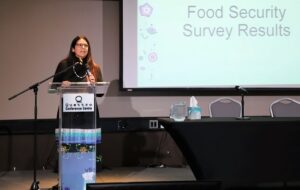‘Food Insecurity affects us all,’ says Dr. Lorilee McGregor at 8th Annual Anishinabek Nation Health Conference

By Jesse Johnson
SAULT STE. MARIE, ONT. – Dr. Lorilee McGregor of Whitefish River First Nation spoke about food insecurity and the effects this has had and will continue to have on Anishinabek First Nations during day three of the 8th Annual Health Conference in Sault Ste. Marie on January 19. She spoke about the cost of food and transportation barriers; the challenges of getting access to traditional food; and, the programs put in place to address food insecurity.
“Not much has been documented on how First Nation communities have been addressing food insecurity so far. Many innovative approaches have been implemented by the 39 Anishinabek Nation communities. The COVID-19 pandemic forced First Nation communities to develop creative ways of addressing food insecurity for their citizens.”
Dr. McGregor shared the questions and answers from one of her recent surveys. Some of the questions and answers from participants are below.
The question: What is food security? yielded the following responses:
“When all people, at all times, have physical, economic, and social access to sufficient, safe, and nutritious food to meet their dietary needs and food preferences for an active and healthy life.”
“Wellness and healing are dependant on having nutritious foods available. Diabetes and heart health is particularly contingent on this. Those with mental and addictions recovery also rely on good nutritious foods in their healing journey. Low-income people and single people are most times clients of the food bank. Families who are in the Child Welfare System are also supported to have good quality foods.
During the discussions, food prices were considered the number one barrier to acquiring healthy food.
“Since late 2021, price increases for food have outpaced inflation, growing faster than 10 per cent in August, September and October 2022,” she explained. “In September 2022, yearly price increases for food (11.4 per cent) rose at the fastest pace since 1981, remaining elevated in October (+11.0 per cent).”
The cost of food and transportation are barriers that also impact food security.
“You don’t get much for your money now. It costs $20 just to get to town. It’s hard to get around to those good vegetables right off the shelf. I get to town maybe once a week, if that. Transportation is a big thing.”
She then spoke about the traditional foods people eat and the challenges they face to eat them. Some of the identified challenges are a lack of knowledge, not being physically-able, decreased availability of plants, animals and fish, fewer hunters, restrictive legislation, and access to land/territory.
“Our hunters know how physically challenging it is to hunt and haul an animal for food. Unfortunately, there’s a lack of knowledge and skills, you need to be physically fit; and there is a decrease in availability of plants, animals, and fish. It takes years of training to hunt,” says Dr. McGregor.
Some programs that have been put in place to address food insecurity include gardening, food banks, grocery cards, cooking programs, food distribution, fishing programs, ride sharing for grocery trips, community hunt, and wild game sharing.
“Teaching grocery shopping skills is important. Try to stick to the outside of the aisles. Focus on the meats, dairy, fruits, and vegetables,” she noted. “Food insecurity can affect anyone in our communities; therefore, it is important to make food programs accessible to all. Real food is medicine.”
For more information about the 8th annual Anishinabek Nation Health Conference, visit www.anishinabek.ca.


